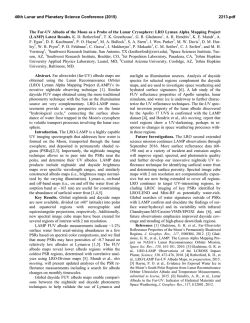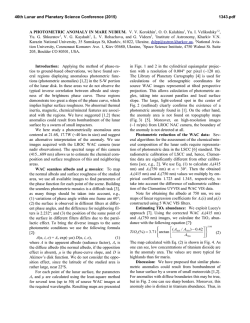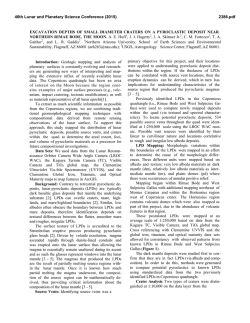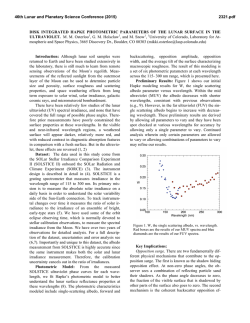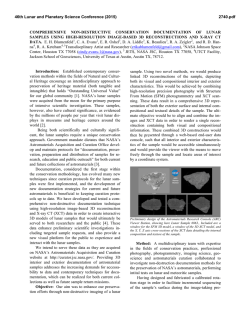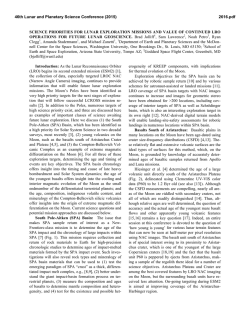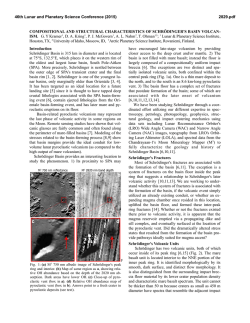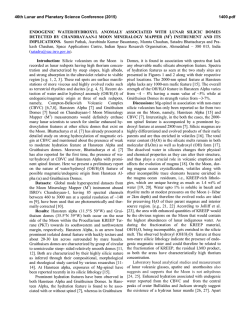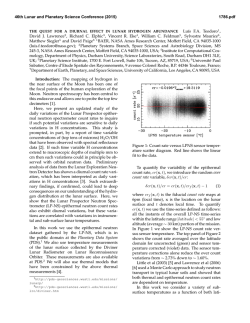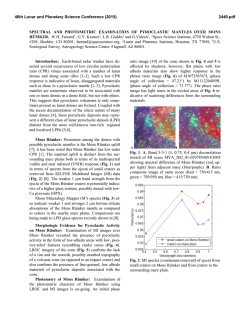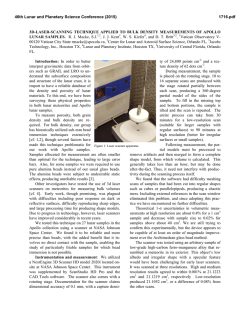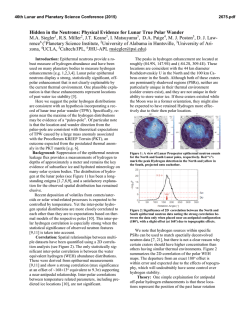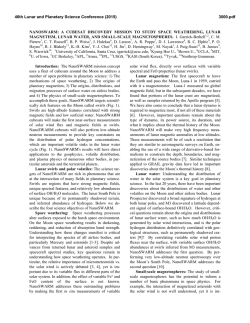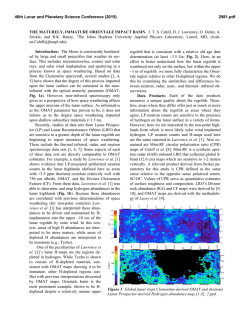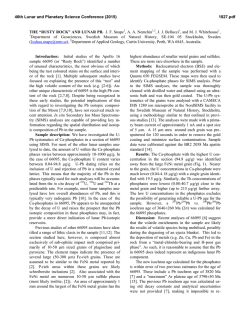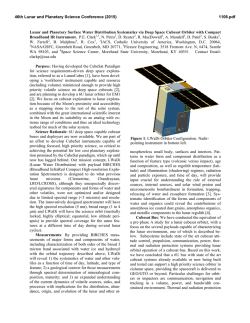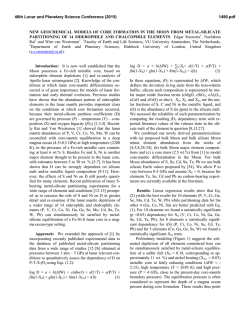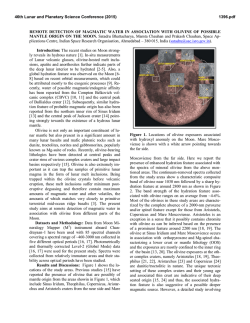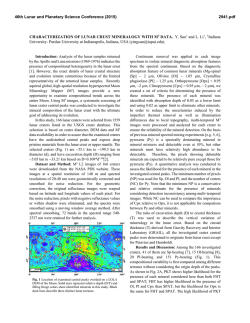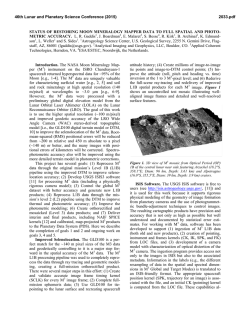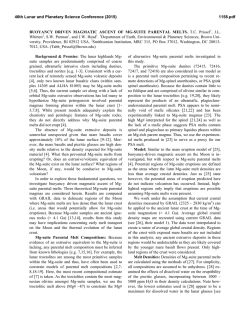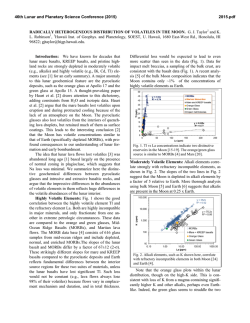
evidence for explosive silicic volcanism on the moon from the
46th Lunar and Planetary Science Conference (2015) 2081.pdf EVIDENCE FOR EXPLOSIVE SILICIC VOLCANISM ON THE MOON FROM THE EXTENDED DISTRIBUTION OF THORIUM NEAR THE COMPTON-BELKOVICH VOLCANIC COMPLEX. J.T. Wilson1, V.R. Eke1, R.J. Massey1, R.C. Elphic2, B.L. Jolliff3, D.J. Lawrence4, E.W. Llewellin5, J.N. McElwaine5, L.F.A. Teodoro6. 1Institute for Computational Cosmology, Department of Physics, Durham University, Science Laboratories, South Road, Durham DH1 3LE, UK, 2Planetary Systems Branch, NASA Ames Research Center, MS 245-3, Moffett Field, CA,94035-1000, USA, 3Department of Earth and Planetary Sciences and the McDonnell Centre for the Space Sciences, Washington University, One Brookings Drive, St Louis, Missouri 63130,USA, 4The Johns Hopkins University Applied Physics Laboratory, Laurel, Maryland, USA, 5Department of Earth Sciences, Durham University, Science Laboratories, South Road, Durham DH1 3LE, UK, 6BAER, Planetary Systems Branch, Space Sciences and Astrobiology Division, MS 245-3, NASA Ames Research Center, Moffett Field, CA 94035-1000, USA. Introduction: Silicic, non-mare volcanism is uncommon on the Moon, observed at only a handful of locations including Hansteen alpha [1], Mairan hills [2], Lassell Massif [3], the Gruithuisen Domes [4] and the Compton-Belkovich Volcanic Complex (CBVC) [5]. These silicic, non-mare volcanic centres have previously been assumed to be similar in nature to terrestrial rhyolite domes [3], which are erupted extrusively. Jolliff et al. [5] suggest that pyroclastic material may have been distributed over distances of a few kilometres from the CBVC but, to our knowledge, no evidence has previously been presented for lunar volcanism that is both pyroclastic and silicic. Here we reconstruct the thorium-line data from the Lunar Prospector Gamma Ray Spectrometer (LP-GRS) (Fig. 1a) using the pixon method to create higher resolution maps of the thorium (Th) distribution around the CBVC. Gamma ray spectroscopy has the advantage, over ultraviolet to near-infrared reflectance spectroscopy, of being able to probe composition at depths of a few tens of cm rather than only the top few wavelengths. Further, in the case of gamma ray detection from the natural decay of Th, uranium and potassium, the inferred abundances do not depend on cosmic ray flux or ground truth but only on having an accurate a background subtraction. These chemical elements are particularly interesting as they have large ionic radii and are incompatible so preferentially partition into the melt phase during magmagenesis, and remain in the melt phase as it crystallizes. Thus the distribution of these elements acts as a tracer of magmatic activity and differentiation. The chemical composition of the Moon’s surface was mapped by the Lunar Prospector spacecraft using gamma ray and neutron spectroscopy [e.g. 6, 7] and these maps have led to an improved understanding of the formation and evolution of the lunar surface and interior [e.g. 8]. Examination of Th abundance maps, along with other data, gave rise to the interpretation that the lunar surface comprises three terranes [8]: the low-Th Feldspathic Highland Terrane; the moderateTh South Pole-Aitken basin; and the high-Th Procellarum KREEP Terrane. Several anomalous regions of the Moon’s surface fall outside this broad classification scheme, most notably a small but distinct Th enrichment located between the craters Compton and Belkovich on the lunar farside. An isolated enrichment of Th was first detected at (60°N, 100°E) in the LP-GRS data [9]. Jolliff et al. [5] associated this compositionally unique feature b Fig. 1a. Raw LP-GRS data binned in the same pixellation that is used in the reconstruction. b. De-blurred Th dstribution near the CBVC. A high Th region (red) approximately 5 times the area of the high albedo feature; its size and mean count rate is well constrained (see Fig. 2), although its precise shape is not. A lower concentration of Th extends ~300 km east, at 5 σ significance. 46th Lunar and Planetary Science Conference (2015) with a ∼ 25 km × 35 km topographically elevated, high albedo region that contains irregular depressions, cones and domes of varying size. They interpreted this region as a small, silicic volcanic complex. Uniquely, the high Th region of the CBVC is not coincident with an elevated FeO terrain (as would be expected from a KREEP basalt); instead the CBVC appears to have a low FeO abundance (∼ 4 − 5 wt.%) that is similar to much of the lunar highlands. Crater counting results indicate a likely age greater than 3 Ga for volcanic resurfacing at the CBVC [10], suggesting that the Th distribution exposed at the CBVC may provide a rare insight into the extent of fractionation and the distribution of such magmatic activity at this time in the Moon’s evolution. One drawback of gamma ray spectroscopy is the large spatial footprint of a gamma ray detector. When the LP-GRS was in an orbit 30 km above the lunar surface, the full width at half-maximum (FWHM) of the detector’s footprint was ∼ 45 km [11]. Additional statistical analysis is therefore required to extract information about the chemistry of sites as small as the CBVC. We use the pixon method [12] to remove blurring caused by the large detector footprint and enhance the spatial resolution of the gamma ray data (by a factor of 1.5 − 2 compared with other image reconstruction techniques [13]), in a way that is robust to noise. This allows us to test the prevailing hypothesis regarding the distribution of Th around the CBVC — that it is all contained within the high albedo region [5]. Reconstructions: The pixon method is a spatially adaptive image reconstruction process that aims to produce the simplest image consistent with the data [12,14]. The reconstructed truth is described on a grid of pixons, where a pixon is a collection of pixels whose shape and size is allowed to vary. The pixon sizes are set by requiring the information content of the image, in the pixon basis, to be flat, which maximizes the image entropy. We found that the standard pixon method was oversmoothing the image at the CBVC (due to the low signal to noise ratio), as the data require a sharp variation in the concentration of Th. We, therefore, allow an area of the image, the ‘high-Th region’, to contain a significantly larger Th concentration than its surroundings, both the area and Th concentration of this region are varied. When the parameters adopted for this region match those giving rise to the LP-GRS data, the best match of data and blurred model should be produced. The best-fit high-Th region in Fig. 1b is considerably larger than the high albedo region identified in Diviner, WAC and NAC imaging [5]. Additionally there is a broad Th enhancement stretching ~300 km east of the CBVC. The range of parameters allowed for the high-Th region is shown in Fig. 2. It is clear from the plot that a model with a high-Th region as small as the ~ 25×35 km2 high albedo region, shown with the black star, is 2081.pdf Figure 2. Constraints on the size and Th concentration in the high-Th region. Coloured regions enclose 68%/95%/99.7% confidence limits. A model assuming that the high Th region coincides with the high albedo feature (black star) is ruled out at 6 σ. disfavoured. The best-fitting decoupled regions cover 3400–5900 km2, corresponding to diameters of ∼ 65– 87 km, with concentrations of ∼ 17–11 ppm. Pyroclastic eruption as a Method of Lunar Transport: The results of the reconstructions show that the Th is presently distributed more widely than the high albedo region. We considered the effect of various post-emplacement processes (sputtering, thermal motion, downslope motion of regolith and regolith transport due to impact processes). However, even cumulatively, they cannot explain the extent of the Th distribution measured in the reconstruction in Fig. 2. Therefore, we conclude that the Th must initially have been emplaced more widely than the albedo feature. We hypothesise, following [5], that the mechanism was a highly silicic form of pyroclastic eruption not evident elsewhere on the Moon. Repeated pyroclastic eruptions from the many volcanic features in the CBVC could feasibly give rise to the observed high and extended Th regions that lie beyond the high albedo feature. References: [1] Hawke B. R. et al. (2009) JGR, 114, E04002. [2] Ashley J. W. et al. LPS LXIV, Abstract #2504. [3] Hagerty J. J. (2006) JGR, 111, E06002. [4] Chevrel S. D. (1999) JGR, 104, 16515-16530. [5] Jolliff, B. L. et al. (2011), Nature Geoscience, 4, 566-571. [6] Lawrence D. J. et al. (1998) Science, 281, 1484. [7] Feldman W. C. (1998) Science, 281, 1489. [8] Jolliff B. L. et al. (2000), JGR, 105, 4197–4216. [9] Lawrence D. J. et al. (1999), GRL, 26, 2681-2684. [10] Shirley, K. A. et al. (2013), LPS XLIV, Abstract #2469 [11] Lawrence D. J. (2003) JGR, 108, 5102. [12] Pina R. K., and Puetter R. C. (1993), PASP, 105, 630–637. [13] Lawrence, D. J. et al. (2007), GRL, 34, L03201. [14] Eke V. R. (2001), MNRAS, 324, 108–118.
© Copyright 2026
